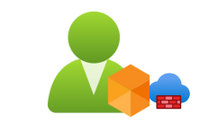
by Contributed | Mar 31, 2021 | Technology
This article is contributed. See the original author and article here.
Network security requirements involve providing limited access and granting administrative permissions to users within a network. Role assignments are the way you control access to Azure back end and infrastructure resources. If the built-in roles do not meet the specific needs of your organization, Azure Role Based Access Control (RBAC) allows account owners to create custom roles that an administrator can assign to Users/User groups.
You can configure role assignments after you have defined the scope, either via Azure Portal, PowerShell, CLI or RestAPI.

In some instances, the built-in roles may be either too permissive or insufficient for the assignment that is required. Access should be provided using the principle of least privilege and every role should be carefully created with the user’s duties in mind, as a security control when creating user privileges. In this situation, you will also need to know what role actions are available.
In this article, we discuss the actions that may be used to create security conscious roles and templates that you can use to create and assign roles for Azure Firewall. Once you understand the boundaries for the role you are trying to create, you can use the template below or modify it by carefully selecting the actions required and assigning it to the user.
There are various levels of administrative roles you might be looking to assign, and this may be done at a management group level, subscription level, resource group level or resource level. Azure RBAC focuses on managing user actions at these different scopes.
To create a custom role, you must provide the following input.
{
"DisplayName": "",
"Description": "",
"Actions": [ ],
"NotActions": [ ],
"DataActions": [ ],
"NotDataActions": [ ],
"AssignableScopes": [ ]
}
You can find the description of each requirement above in this article. To configure Azure roles using PowerShell, follow the steps to create a custom role.
Click the “Deploy to Azure” button below to deploy a template for the Network infrastructure role discussed below from Github. You can use this custom template by editing the “action” field for the appropriate set of actions list in the samples below. Then provide the Principal ID(Object ID) of the user to assign the role. You can find a detailed step by step guide here.

The following 3 administrator examples are common in network scenarios:
Firewall Security Administrator
This role is assigned to an admin that is responsible for the security configurations in the network. Access control is used to manage connectivity, making sure actions are carefully assigned. This admin can analyze the security risk of each connection via the network and application rules and make changes as required.
"Microsoft.Network/azureFirewalls/networkRuleCollections/delete",
"Microsoft.Network/azurefirewalls/write",
"Microsoft.Network/azureFirewalls/applicationRuleCollections/write",
"Microsoft.Network/azureFirewalls/applicationRuleCollections/delete",
"Microsoft.Network/azureFirewalls/natRuleCollections/write",
"Microsoft.Network/azureFirewalls/natRuleCollections/delete",
"Microsoft.Network/azureFirewalls/networkRuleCollections/write",
"Microsoft.Network/azureFirewalls/networkRuleCollections/delete",
"Microsoft.Resources/deployments/*",
"Microsoft.Network/firewallPolicies/ruleCollectionGroups/write",
"Microsoft.Network/firewallPolicies/read",
"Microsoft.Resources/subscriptions/resourceGroups/read",
"Microsoft.Insights/alertRules/*",
"Microsoft.Resources/subscriptions/resourceGroups/*",
"Microsoft.Support/*"
Firewall Security Reader
This administrator requires mostly reader privileges as maybe required in an auditor role. The permission grants visibility into existing rules and other properties of the firewall. This user is therefore only able to view and not make changes
"Microsoft.Network/azurefirewalls/read",
"Microsoft.Network/azureFirewallFqdnTags/read",
"Microsoft.Network/azureFirewalls/applicationRuleCollections/read",
"Microsoft.Network/azureFirewalls/natRuleCollections/read",
"Microsoft.Network/azureFirewalls/networkRuleCollections/read",
"Microsoft.Resources/subscriptions/resourceGroups/read",
"Microsoft.Network/firewallPolicies/ruleCollectionGroups/read",
"Microsoft.Network/virtualNetworks/read",
"Microsoft.Network/firewallPolicies/read",
"Microsoft.Network/firewallPolicies/ruleCollectionGroups/read",
"Microsoft.Resources/subscriptions/resourceGroups/read"
Network Infrastructure administrator
This role has more overarching rights to change the infrastructure of the firewall from a network operations perspective, but would not necessarily need access to change network and application rules like the security admin, hence viewer access. Permissions in this role include FirewallWallPolicies attributes such as: Threat Intelligence, DNS settings, Intrusion detection etc.
"Microsoft.Network/azurefirewalls/delete",
"Microsoft.Network/azureFirewalls/networkRuleCollections/read",
"Microsoft.Network/azurefirewalls/read",
"Microsoft.Network/azureFirewalls/applicationRuleCollections/read",
"Microsoft.Network/azureFirewalls/applicationRuleCollections/read",
"Microsoft.Network/azureFirewalls/natRuleCollections/read",
"Microsoft.Network/azureFirewalls/natRuleCollections/read",
"Microsoft.Network/azureFirewalls/networkRuleCollections/read",
"Microsoft.Network/azureFirewalls/networkRuleCollections/read",
"Microsoft.Network/firewallPolicies/*",
"Microsoft.Network/ipGroups/*",
"Microsoft.Resources/deployments/*",
"Microsoft.Insights/alertRules/*",
"Microsoft.Resources/subscriptions/resourceGroups/read",
"Microsoft.Support/*",
"Microsoft.Resources/subscriptions/resourceGroups/*"
To remove the example role when done, use the following command in PowerShell:
Remove-AzRoleDefinition -Name “Custom Role - Firewall InfraAdmin"
Note: You may need the subscription owner permission if it’s the first time deploying an Azure Firewall instance in that subscription for the first deployment. This can also be achieved by registering the provider: Microsoft.ContainerService before creating the firewall.
Role Definitions use a GUID for the name, this must be unique for every role assignment on the group.
The roleDefName parameter is used to seed the guid() function with this value, change it for each deployment.
You can supply a guid or any string, as long as it has not been used before when assigning the role to the resourceGroup.
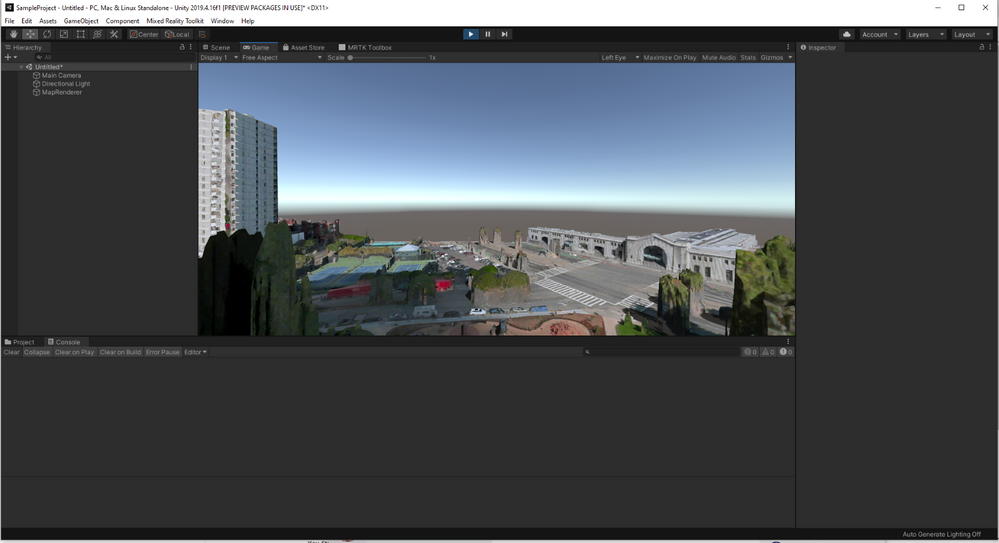
by Contributed | Mar 31, 2021 | Technology
This article is contributed. See the original author and article here.

When Microsoft Flight Simulator came out a year ago, I was completely entranced by it. I’m not particularly into hyper-accurate flight simulation games, but the concept of a game where you can go anywhere in the real world and see an accurate 3D representation of that real-world space, blew my mind. What a concept! That also got me thinking: could I make something like that myself? As a solo creator I don’t have the benefit of a team of many engineers working with map data for years.
How Flight Simulator’s World Works
Microsoft Flight Simulator uses three distinct types of world maps:
- Azure 3D Maps. Flight Simulator uses high-quality 3D photogrammetry data when it exists in Microsoft’s library. It’s pretty easy to identify these areas: there are relatively high-quality textures, but often buildings and landmarks like trees look a bit worn down as the 3D models aren’t perfect.
- AI-Augmented 2D Satellite Maps. For areas where no good 3D map data is available, Flight Simulator takes 2D satellite map footage instead. Deep learning techniques are applied to infer what sort of 3D buildings and landmarks might exist, and then a library of hand-authored 3D models are programmatically placed in the world. If you’re visiting a relatively non-descript location in Flight Sim where buildings look pristine and high-quality, you’re probably in an AI-augmented zone.
- Hand-authored content. A lot of Flight Simulator areas are modeled by hand to resemble their real-world locations. Notable examples include the hand-modeled airports in the Deluxe and Premium Deluxe editions of the game.
The second and third types of map data require an exorbitant amount of work, either designing procedural generation algorithms or doing 3D modeling and level design by hand. But the first one is doable!
Specifically, the Bing Maps SDK gives us exactly what we want: a drop-in Unity component that, given a location (via latitude/longitude coordinate pair) will render a 3D scene containing that real-world location, powered by the same 3D maps data that Flight Simulator uses. That’s so cool! I’m going to spend the remainder of this blog post walking you through setting up a pretty simple VR “flight sim” example that will let you move around a 3D representation of any location in the world!
I’m going to assume you have basic familiarity with Unity to configure a few GameObject components and write a small amount of custom code. If this is more than you’re comfortable with, please check out other tutorials to familiarize yourself with Unity’s UI.
Get a Bing Maps API Key
To use this API, you need an API key. Sign in or sign up at the Bing Maps Portal. Once you’re logged in, create a new API key by going to My account -> My Keys -> Create a new key. Name it whatever you want, choose a “Basic” key, and for now select “Dev/Test” as the application type.

After creating a key, keep this page handy, as you’ll need the key in a few minutes.
Download the Bing Maps SDK and open the sample project
For now, we’re going to use the sample starter project included with the Bing Maps SDK, although there are instructions if you would prefer to integrate the SDK manually with an existing or new project using the Unity Package Manager.
Grab the 0.10.0 release of the SDK from this page and unzip it. In Unity Hub, click “Add”, then locate this folder and select the “SampleProject” folder. If you don’t have a Unity 2019.4 release, Unity Hub may prompt you to download and install it.
Creating our scene
Start by adding a new scene by selecting File -> New Scene.
Add a new empty GameObject to your scene by right-clicking anywhere within the Hierarchy window and selecting “Create Empty”. I called mine “MapManager” (since it’s going to manage our 3D map component).
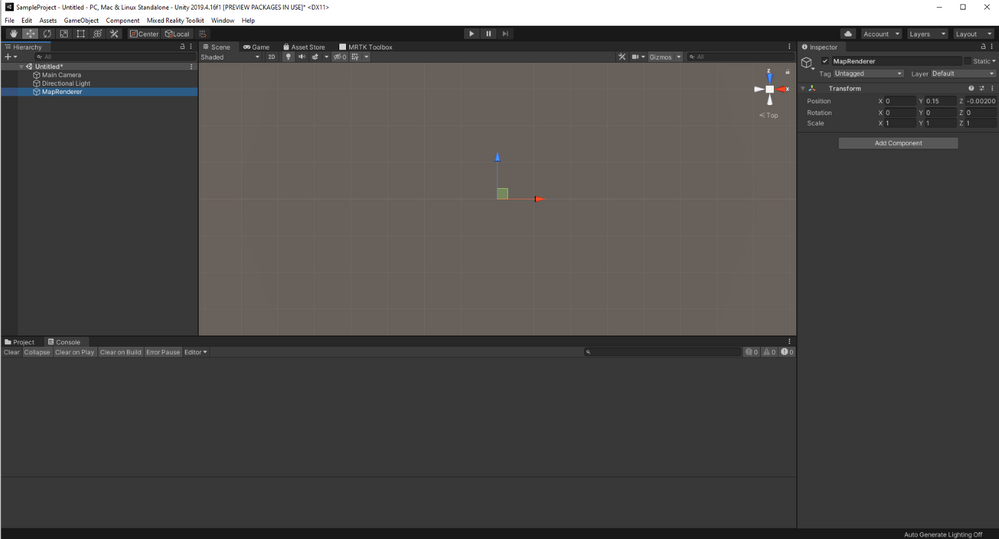
In the right-side inspector pane for this new GameObject, click the “Add Component” button and search for the “MapRenderer” component. This is a Unity component provided by the Bing Maps SDK for Unity that will automatically render our 3D map in our scene!
In the GameObject inspector pane, enter your API key from the Bing Maps Portal earlier into the Developer Key field in the Map Session pane. Add in the lat/long coordinates for the location where you want players to start their adventure into the “Location” fields at the top of Map Renderer.
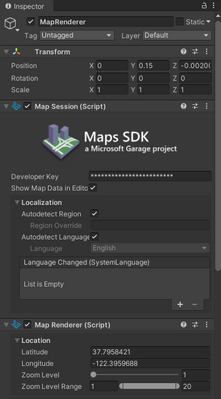
I set mine to a latitude of 37.7958421 and a longitude of -122.3959688, which is the Ferry Building in downtown San Francisco. I found this by looking up the Ferry Building in Bing Maps and right-clicking the Ferry Building. If there’s a location you’d rather explore in 3D, you can get its lat/long coordinates the same way and enter them instead.
Now you will see a map of the world in your Unity scene! If you adjust the “Zoom Level” slider below latitude and longitude, you can see it zoom in on San Francisco (or your chosen location). I’ve found that setting the zoom to 19 is a good fit for our use case.
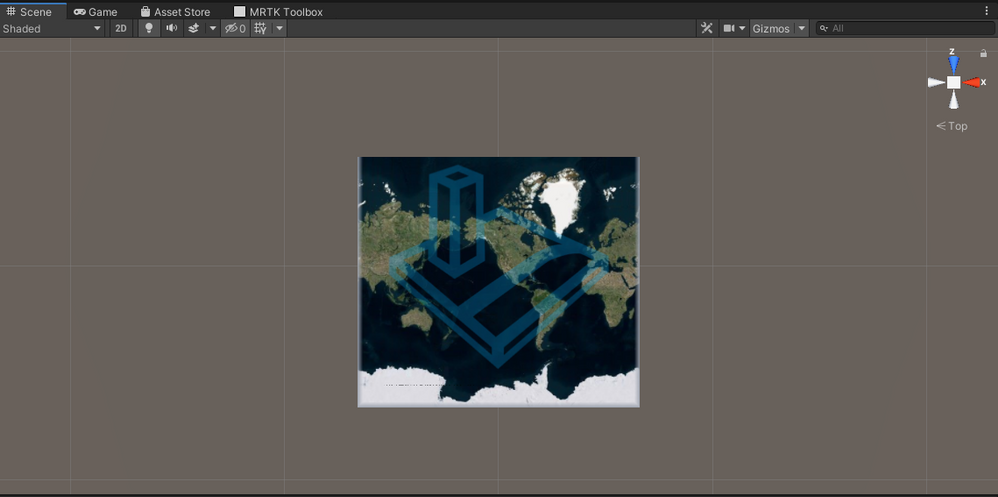
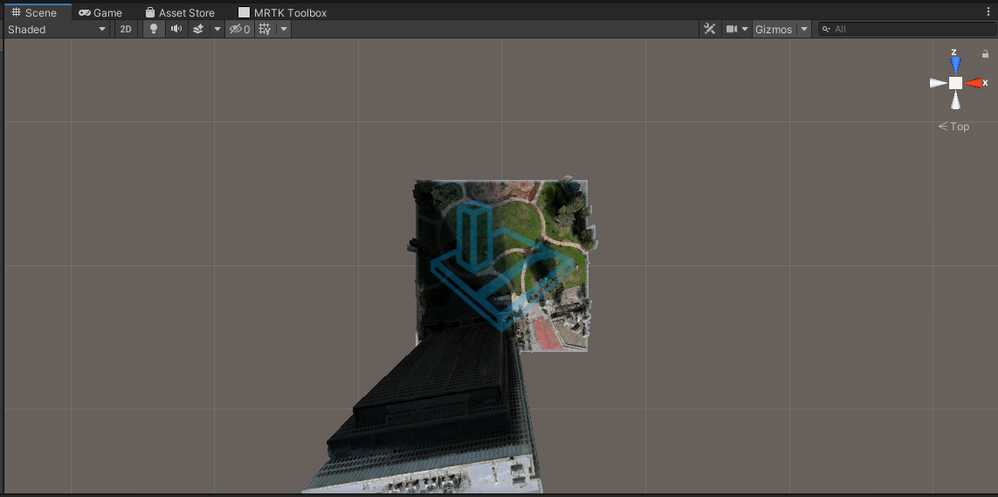
If you were to open this in VR now, it would look more like a diorama than a lush living world. Let’s make it bigger to match the scale of a person in VR! In the Transform section at the top of the inspector, set it’s the scale to (20, 20, 20). Down in the Map Layout section of the Map Renderer tab, set the Local Map Dimensions to (3, 3). This should make the map much larger and more to-scale with a human-sized VR viewer.
One final piece to the puzzle is moving the camera position. Since we’ve grown the map to be as tall as 20 units tall, but the camera is still down at the original starting point, trying to play this in VR would spawn you in the middle of the ground! Select the Main Camera object from the scene inspector, and set the camera position to (0, 12, 0). This should get you a good vantage point of the scene.
Give it a try!
Click the “Play” button in the top middle of the Unity editor now and see a fully-rendered 3D map of the location you’ve entered! If you have a VR headset connected to your computer, it should automatically render to the VR headset as well, including using head tracking to control the camera and let you look around.

Moving Around
It’s so cool that with such little work we’re already able to drop ourselves into a 3D rendering of the actual world! But we can take this further: let’s add some movement! As mentioned, I’m not particularly into detailed simulations, so for now let’s just add some super simple movement code. Hold down a button on your VR controller to move at a reasonable speed in whatever direction you are currently looking.
With our custom GameObject open in the inspector, click “Add Component”, then “New script”, and call it CameraMovement. Double-click the C# script name in the inspector to open it in your text editor of choice, then paste in the following code. Don’t worry, I’ll walk you through it in a moment!
using UnityEngine;
using Microsoft.Geospatial;
using Microsoft.Maps.Unity;
public class CameraMovement : MonoBehaviour
{
void Update()
{
if (Input.GetButton("Fire1")) {
var heading = Camera.main.transform.eulerAngles.y * Mathf.Deg2Rad;
var speed = 0.00015f;
var map = GetComponent<MapRenderer>();
map.Center = new LatLon(
map.Center.LatitudeInDegrees + speed * Mathf.Cos(heading),
map.Center.LongitudeInDegrees + speed * Mathf.Sin(heading)
);
}
}
}
Let’s walk through this!
if (Input.GetButton("Fire1")) {
Every time the Update function is called (for a VR project, usually 72 or 90 times per second), we’re going to check if the player has pressed the “Fire1” button on their VR controller. On most VR headsets, the Mixed Reality Toolkit maps this to a prominent “main” button on the face of the controller (and not a trigger). If the player is pressing the button on this frame, we will want to move the player!
var heading = Camera.main.transform.eulerAngles.y * Mathf.Deg2Rad;
This fetches the current y-axis value of the main camera, which is being controlled by the VR headset. The y axis is the equivalent of turning your head left or right. This means we won’t let players move up or down, but that’s fine for our simple use case. The Mathf.Deg2Rad multiplication is just to get that value as a radian instead of degrees since that’s what our trigonometry functions will take a few lines down.
var speed = 0.00015f;
How many world units players will move per frame they’re moving. I hand-tuned this value based on testing. Feel free to make yourself faster or slower!
var map = GetComponent<MapRenderer>();
Grabs a reference to the MapRenderer map object off of our GameObject.
map.Center = new LatLon(
map.Center.LatitudeInDegrees + speed * Mathf.Cos(heading),
map.Center.LongitudeInDegrees + speed * Mathf.Sin(heading)
);
This may look complicated if you’re rusty on basic trigonometry, but it’s not that bad!
The first thing to understand is a classic videogame movement trick: we’re not moving the player, we’re moving the entire world around the player like they’re on a treadmill. We’re neither moving the camera nor the position of the map view in the scene; we’re simply shifting what latitude and longitude coordinates are at the center of the map, which will result in the map moving (slightly, since we’re dealing with very small changes) and a perception that the player is moving.
Given our goal of moving 0.00015 units per frame, multiplying that speed by the sin and cosine of the angle ensures that, while we shift both the latitude and the longitude, we change them proportionately so that the total distance moved is exactly 0.0015.
If you click “Play” and put on your VR headset, it all should work now! Pressing the “fire1” button on your controllers (it may take some experimentation to find it) should move you in the direction you’re looking.
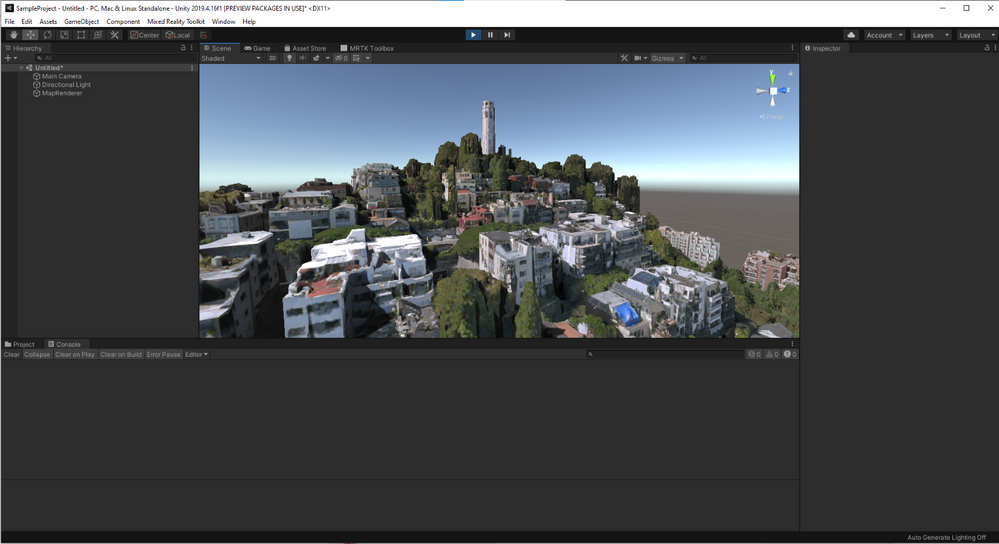
I don’t know about you, but I’m pretty blown away at how impressive this looks after such relatively little work! You could imagine expanding this to include more complex controls, real flight physics, goals and objectives, or whatever else you want, but for now this is a heck of a demo for such a short period of time and such little code.
Building more weird things with real-world data
Separate from how much I love this specific experience of being able to soar around my favorite cities of the world, this also points towards one of my favorite ways to build games and mixed reality experiences: on top of already-existing real-world data sources.
If you’re working by yourself, building a 3D scale model of whatever city you live in is likely prohibitively expensive. The thought of building a game where you can fly around an entire city-scale map, let alone a world-scale one, is extremely time-consuming and requires a whole bunch of disparate skillsets, even if you’re taking advantage of resources such as existing Unity Asset Store assets. In this case, finding something like the Bing Maps SDK that provides you with a 3D scene makes it categorically possible for you to make projects and experiences that wouldn’t be possible otherwise.
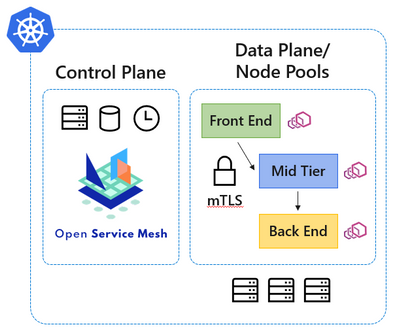
by Contributed | Mar 31, 2021 | Technology
This article is contributed. See the original author and article here.
Microservice architectures have become the de facto standard for cloud native applications, and organizations are continuing to adopt, grow, and harness the Kubernetes platform for their applications’ needs. Along with the rapid volume of Kubernetes adoption comes the operational complexity to maintain and secure the vast amounts of application endpoints in these cloud native environments.
Since our initial announcement of Open Service Mesh (OSM) as an open-source community-led project back in August 2020, and later being accepted to the Cloud Native Computing Foundation (CNCF) as a sandbox project in September 2020, the core principles that inspired the project continue to ring true. Those core principles were to develop a cloud native service mesh that is simple to understand and contribute to; effortless to install, maintain, and operate; painless to troubleshoot; and finally keep OSM easy to configure via the Service Mesh Interface (SMI) specification. We are thankful to the community and all the individuals, contributors, and maintainers for their hard work in keeping the core principles at the forefront of the project.

In our efforts to provide a simplified service mesh experience for securing your cloud native application communications and endpoints, today we are excited to announce the public preview of the Open Service Mesh (OSM) Azure Kubernetes Service (AKS) add-on. Azure customers will benefit now by being able to experience first-class Azure support on a fully integrated cloud native application stack provided with AKS.
OSM is being developed as an open-source project with the CNCF, and as the project continues to mature, those enhancements will continue to inform the OSM AKS add-on. This working model with the open-source community not only allows us to rapidly develop features, but also allows us to work closely with the community in prioritizing the experiences and functionality expected by end users. We look forward to your experiences with the OSM AKS add-on.
If you are ready to get started with the public preview of the OSM AKS add-on, please visit our documentation at https://docs.microsoft.com/azure/aks/servicemesh-osm-about , which will provide more information about how to get started with the add-on for your AKS environment. We look forward to hearing about your experiences with the OSM AKS add-on.


Recent Comments